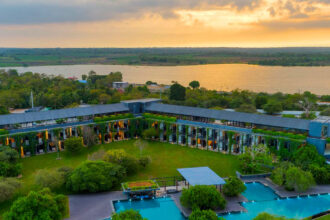Sri Lanka is one of the most beautiful countries in Asia and just so incredibly diverse. Because of its small size, you can easily cover the entire country during a two-week holiday. However, because Sri Lanka is rich in culture, scenery and heritage, thorough tour planning is advisable. As a tourist travelled around Sri Lanka I have complied this list of important things I learned that could help you if you are planning to visit Sri Lanka.
1. Pack a sarong for your day tours
Sri Lanka is usually hot and humid. While you should dress conservatively (and the locals really do), I physically couldn’t wear shorts throughout my stay. That being said, there are certain areas, especially temples, where it is definitely not okay to wear shorts.
Buy a sarong (they are cheap at Rs500- Rs1000) at any local clothing store. A sarong is great to wear in bed at night if you’re staying in one of those village places that don’t provide a sheet to cover yourself with. Pack a sarong on your day trips. A sarong is easy to wrap around your hips, easy to store in your day pack, and the traditional way to enter Hindu temples. Naturally, long pants do the job as well.
Sri Lanka Holiday Guru tip: You will be required to leave your shoes at the entrance to temples– so bring some socks as the ground will often be unbearably hot.
Read: Seasons and weather in Sri Lanka months, when to go in Sri Lanka
2. Start your days early
Sunrise is around 06.00hrs and sunset is usually around 18.00hrs. The best photos and views are before the sunrise and sunset depending on where you are in the country. It’s advisable to start the day early if you’re to experience good scenery.
Tip: It can get incredibly hot during the day time. If you plan to go sightseeing, better to avoid the midday heat. If you plan to climb Sigiriya or visit Polonnaruwa, you’ll avoid the heat by going there as soon as the gates open. (Gates open at 08.30hrs.)
Read: Weather in Sri Lanka
3. Research tipping culture
Not all countries in Asia value tipping – but Sri Lanka is one of them that does. Basic salaries in the hospitality industry are low and a decent tip encourages as well as rewards good service. It will also result in a guest getting more personalised attention on a return visit.
So, how much should you tip in Sri Lanka?
It’s a tradition in Sri Lanka to tip if satisfied with the service. Most restaurants include a service charge of Rs10% in the bill. If you are paying with a credit card and want to reward good service directly, then give the server a tip in cash. (We suggest half of the 10% service charge that’s been added to the bill).
If there’s no service charge included, then tip 10% of the bill in cash direct to the server.
It is customary to tip the hotel bell boy who identifies your luggage and brings it to the room. Rs100 to Rs200 per bag should do. Colombo hotel doormen who are especially helpful deserve Rs500 from time to time. Whether you tip the staff from housekeeping who clean your room, depends on whether you ever see them, and on the room rate.
If you do see them and are really satisfied with their performance, Rs200 a day per guest is OK for a basic establishment, or Rs500 day per guest for a super place. But really it depends on the relationship you build up with staff during your stay.
Read: Tipping guidelines in Sri Lanka
4. Know when it is Full Moon
Shops and restaurants are open all week long – except on days of the full moon, which are public holidays. It is known as Poya Day in Sri Lanka. Buddhist use this day to visit temples for religious observances.
Tourist restaurants, especially at hotels, are still open, but alcohol is not served. If you still want to enjoy your booze in private, stock up before the Poya day. Public drinking is illegal.
Read: Guide on Alcohol, Beer, Wine, Arrack, Toddy and Gin
5. Internet – Wi-Fi and data
4G is readily available here, and the speeds are very good. Buying pay-as-you-go credit is very cheap. Mobile top-ups cards are freely available in grocery shops and supermarkets.
Dialog has free sim cards available to travellers at the airport. Rs1,300 will give 9GB of data and Rs350 worth of local calls. To top up, simply head to any little convenience shop.
Wi-Fi is available in main tourist areas, coffee shops, hotels and shopping malls.
Read: WI-Fi and internet guide in Sri Lanka
6. Prepare for high humidity
The humidity in Sri Lanka is exceptionally high and It’s higher in the rainy season. Seventy per cent humidity could be expected around Colombo during the dry season. Below are two important things you should know about humidity in Sri Lanka.
First of all, temperatures will feel way higher than they are. While the thermometer might “only” read 86-90º Fahrenheit / 30-31° Celsius, it will often feel like 40º – especially in the sun.
The high humidity will leave clinging dampness to your clothes – especially if you have visited the central highlands (like Kandy or Nuwara Eliya) first. If you stay long, clothes, especially jeans, may start smelling a bit odd.
7. It’s hard (and expensive) to buy cigarettes
Sri Lanka has strict anti-smoking laws. Cigarettes are expensive, due to high tariffs. You’ll find them on sale by the cashier’s counter in supermarkets and at village stores, where a single cigarette can be bought.
Smoking is not allowed in public places. If you want to make friends with locals, offering a cigarette goes a long way.
Bringing cigarettes with you, even for your own use, is prohibited by customs and they are not offered for sale in the duty-free shop on arrival
Read: Smoking and the law in Sri Lanka
8. Pick the right time to visit national parks (and invest in good guides/ tours)
Sri Lanka is home to a number of national parks. While you will be able to see wild animals all year round, there are some times of the year with a higher chance to see the more elusive ones. Generally speaking, the height of the dry season forces animals to the water holes, which makes them easier to spot in the vicinity. Migratory birds, on the other hand, can only be seen in the winter months.
A lot of animals are nocturnal, such as the mighty leopard. If you want to see one, you should try for the last hours before dusk. It’s then you have the highest chance to see one – often lounging on rocks and other warm surfaces.
Also, try to pick experienced guides. If you just book the cheapest tour in Yala National Park, for example, you might end up driving through the press of jeeps at the very entrance, with little chance to see anything.
Read: Top five national parks in Sri Lanka for seeing Elephants
9. The local food is spicy food and drinks are cheap
Sri Lankan food is absolutely delicious, and the local and street food is extremely affordable.
Fish curries are extremely popular, but there are quite a lot of vegetarian (like Dhal Curry) and meat options as well. Sample them all, get some hoppers (like a crisp pancake), string hoppers (like noodles), rice or Kottu roti to go along with it and enjoy. Just be prepared for quite some hotness, and make sure to inform the waiter before you order if your stomach can’t handle too spicy food.
It usually doesn’t work out all that well, but it’s worth a try. You should not leave the country without having tried the local food at least once – there is a reason every Sri Lanka travel guide mentions it.
Street food Rs300 – 500
Rice and Curry Rs250-400
Main local meals Rs450- Rs700
Expensive western meals Rs1000 – Rs1500
Lion and Tiger Beer Rs600 – Rs800
Alcohol is very expensive in Sri Lanka if you buy as shots in a pub. Buying the bottle in a Wine store is cheaper but still more expensive than in source countries.
Bottled Water Rs50 for 500ml and Rs100 for 750ml
Read: Food etiquette in Sri Lanka
10. Bring an umbrella or hat to fend off the sun and weather in Sri Lanka
Walking around Sri Lanka, you will notice a lot of locals using umbrellas to escape the sun. While some of them are probably trying to avoid that tan, it really helps to keep off the worst of the heat as well. Walking along the ramparts of Galle Fort I really felt like going through a furnace and an umbrella made it bearable – much to the envy of so many other tourists. (You can buy a collapsible umbrella quite cheaply in local stores.)
Sri Lanka’s weather is punctuated by two separate monsoons affecting different parts of the island at different times of the year, your trip will require a little pre-research to know what’s ‘in season’.
The main monsoon, “Yala”, occurs from April/May to September on the west and south-west coasts (including main tourist sites such as Galle, Unawatuna, and the southern coast), with the wettest months from April – June.
The less severe “Maha” monsoon usually hits the east coast from November to March (includes Arugam Bay and Trincomalee).
If you’re wanting to enjoy the incredible sights of the south and central areas, December to March is the best time to visit Sri Lanka.
Alternatively, if you’re keen to hit the surf breaks of Arugam Bay and Trincomalee, April/May to September is the best time to visit Sri Lanka.
11. MONEY MATTERS | WHAT’S SRI LANKA’S CURRENCY?
Sri Lanka’s currency is the Sri Lankan Rupee. The currency code is LKR.
Denominations include Rs10, Rs20, Rs50, Rs100, Rs500, Rs1000, Rs2000, Rs5000.
The exchange rate currently (Automatic link for exchange) link to the survival guide on money changing
From tuk-tuk drivers to restaurants, grocery stores to independent tour operators, this is a country that runs on cash.
Read: Currency and currency exchange in Sri Lanka
12. CASH OR CARD IN SRI LANKA?
While ATM and card facilities are pretty widely accessible in the main tourist areas, they can’t always be relied upon.
I’d recommend withdrawing as many Sri Lankan rupees as you need in batches (from the ATM rather than a currency exchange so you don’t get ripped off), and using that to pay your way instead. However, do inform your card issuer in advance that you intend using the card in Sri Lanka and also remember there will be commission charged, so an official currency exchange bureau may be a better bet after all.
13. Mosquitoes
Bring mosquito repellent if you are sensitive to mosquito bites; mosquito nets can be provided in guest houses or mosquito coils can be burned at night. Supermarkets stock coils, electric anti-mosquito mats or vapours and sprays
Read: What to do if you are sick in Sri Lanka? Free medical care for tourists
14. Don’t drink the tap water
Drinking the tap water in Sri Lanka is not recommended. Bottled water and boiled water are available in restaurants and shops
Bottled water is cheap Rs50 for a 500ml, a 750ml for R100-150. Just make sure to dispose of the plastic bottles properly.
Note: At many tourists attractions, especially Sigiriya, Hortain Plains, the staff will check your bags for plastic bottles and will request you to remove the plastic seal wrapped around the bottle so you don’t litter the place. So, make sure you help Sri Lanka to fight plastic.
15. Reserve a train seat to or from Ella in advance.
The train ride to and to and from Ella is incredibly popular. Personally, I’d try to avoid it, as the train through the hill country is super slow, it’s incredibly touristy and the train can be extremely crowded. But if you want to go, reserve your seats 30 days in advance. If you turn up at the station on the day of departure and buy a ticket, this probably means you will have to stand for hours as all the seats will be taken!).
There are a couple of online agencies that will help you. The tickets are fairly cheap, so it’s definitely a very valid option (and quite eco-friendly) for those travelling through Sri Lanka on a budget. Taking a Taxi like PickMe is probably better, as you can stop along the route, take pictures of the beautiful Nine Arch Bridge and so on. Also, you’ll avoid taking yet another picture of somebody hanging out of the train with tea fields in the background.
Reservations can be made in person from 30 days in advance from
Colombo Fort Railway Station (Reservation Office) 011-2432908
Kandy Railway Station 081-2222271
Badulla Railway Station 055-2222271
Reservations can be done by dialling 365 from local Mobitel/Etisalat Phone Lines and 1365 by SLT phones from 30 days before the date of the journey ( For Intercity/AC Intercity Trains )
16. Don’t forget to apply for a visa
Citizens of most countries need a visa to enter Sri Lanka. It’s actually quite easy to do online: Here’s the official website to do so. (link)
It takes like five minutes to apply and will cost you US$35 per person. There really is no need to go via an agency. Just make sure to double-check all your details, as the visa will be invalid with even the slightest typo. You’d have to pay for another visa at the airport, Visas are also available at the airport, at a separate counter from the immigration desks, but be prepared for a long queue.
Read: How to get visa to Sri Lanka
17. Hide that Buddha tattoo
For whatever reason, Buddha tattoos are quite popular among western people. Sri Lankans will react differently as they are very sensitive for their religion, and you should definitely make sure to cover it up at all times. This also applies to any fashion items with an image of Buddha on it.
Also remember, you should never pose for a photograph with your back towards a Buddha statue. Things like that could get you into serious trouble.
Read: Guide on visiting a place of worship in Sri Lanka
18. Your credit card might not work
Withdrawing money from an ATM or paying with credit card is not always an easy affair. Alert your credit card issuer in advance of your trip and your intention to use the card in Sri Lanka. It’s advisable always to carry some Sri Lankan rupees (exchange foreign currency for rupees at the banks at the airport) for the many places that don’t accept credit cards.
Read: Credit cards usage in Sri Lanka as a tourist
19. Driver guides and guided tours
There are different kinds of tourists in Sri Lanka: budget travellers and backpackers usually stick to tuk-tuks and trains. If you are like me, and a bit too old for this kind of travel style, you can hire a personal driver-guide who will show you around the island. It’s actually the best way to see the island, if not the cheapest. You could also opt to tour by a bus or by hired mini-van.
Most of these drivers and tours are affiliated with restaurants, jewellery shops, and spice gardens. So at one point or another, they will stop at those venues. Some of them are actually somewhat interesting (if you haven’t seen the like before), but you should definitely know that the prices of what you buy will be inflated for commission payments.
Rather shop at a local market or at the supermarkets if you want spices or tea. For jewellery I recommend the stores in Galle Fort – just make sure you buy something with a valid certificate proving authenticity.
20. Cheap and crazy buses
Buses can be an incredibly cheap way to get you anywhere.
But you should also know that most of the bus drivers are downright suicidal and a lot of accidents happen every month. The traffic in Sri Lanka is quite different than in Europe or the USA, and it might shock some people just how crazy it all is. So, know what you are getting into, and consider taking the train or book a taxi like PickMe instead.
If on a bus always ask for the ticket with the price mentioned.
Read: Transportation in Sri Lanka (Tuk-Tuks, Cars, Mini Car Taxi)
21. Entrance fees can be extremely expensive
Sri Lanka is, all things considered, quite the budget destination. US$50 a day will get you very far. With one exception: The entrance fees to the UNESCO World Heritage sites and National Parks.
To give you a good indication: You can get curry with some hoppers for Rs200, but they will charge you US$30 to climb Sigiriya or US$15 to enter Yala National Park (that’s without a guide, vehicle, etc).
To be quite honest with you, I find these prices are fair – especially as they are used to preserve these important landmarks and wonders. Still, it can set back your vacation funds quite a bit, so plan ahead!
22. The beautiful beaches can be deceiving
Sri Lanka has some spectacular beaches. Golden sand, palm trees, and a gentle breeze invite you to stay awhile. But, there are two things you should know:
The Sri Lankan sun is incredibly intense, and you will definitely need an umbrella or a place with some shade.
The currents of the Indian Ocean can be very strong and treacherous, and the waves will usually be high. It’s the perfect place to go surfing, but swimming requires a bit more experience.
I don’t say this to convince you a Sri Lanka beach vacation is not recommended, but rather so you come prepared! East coast or west coast, I loved swimming in Sri Lanka. Also, the conditions are perfect for whale watching (by boat or light aircraft).
Read: Swim safely in Sri Lanka
Read: Guide on surfing in Sri Lanka
Send your tips to [email protected] so we can upload them here for other tourists to enjoy Sri Lanka too.
Subscribe to our newsletter to get our newest articles instantly!










